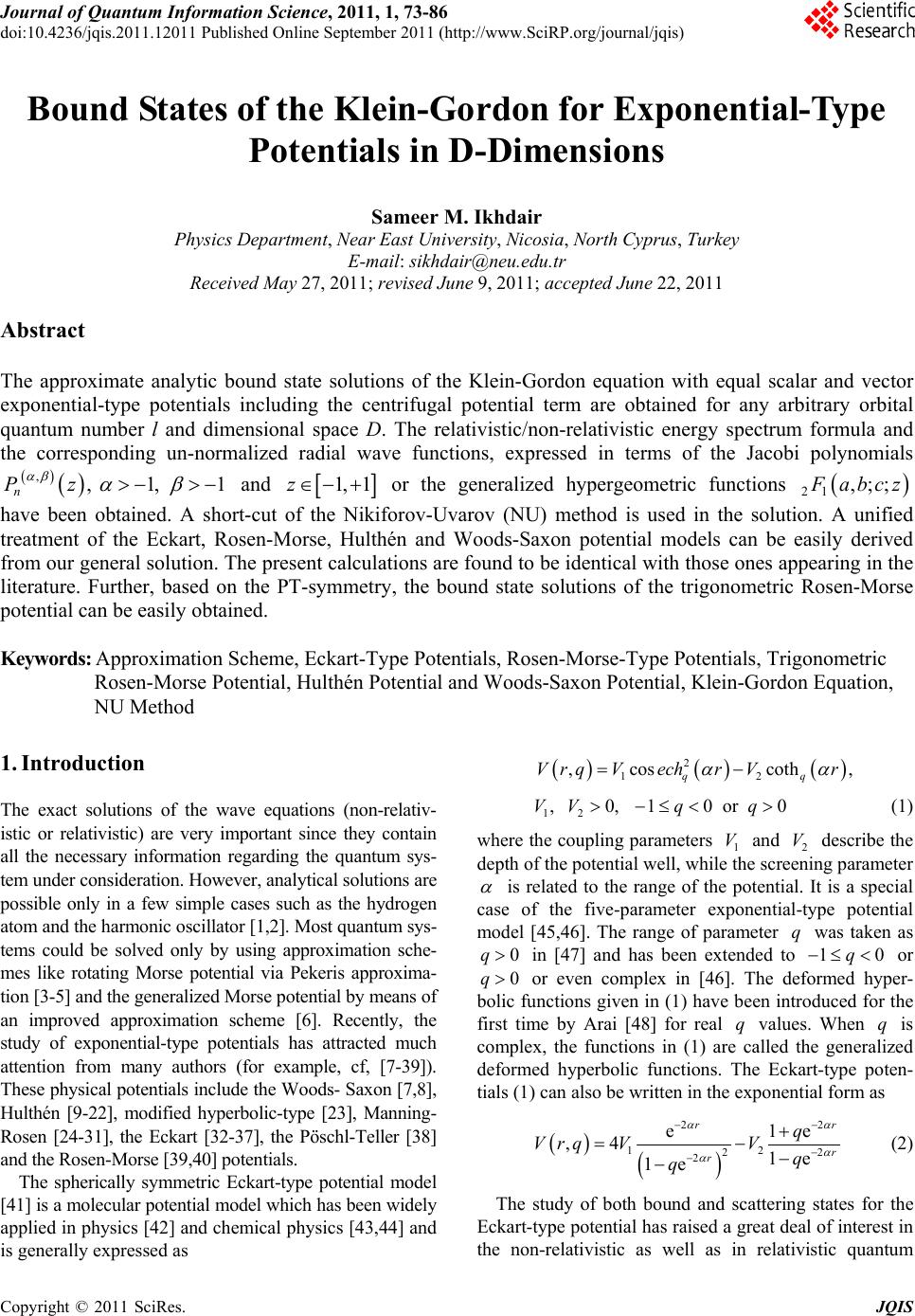 Journal of Quantum Informatio n Science, 2011, 1, 73-86 doi:10.4236/jqis.2011.12011 Published Online September 2011 (http://www.SciRP.org/journal/jqis) Copyright © 2011 SciRes. JQIS Bound States of the Klein-Gordon for Exponential-Type Potentials in D-Dimensions Sameer M. Ikhdair Physics Department, Near East University, Nicosia, North Cyprus, Turkey E-mail: sikhdair@neu.edu.tr Received May 27, 2011; revised June 9, 2011; accepted June 22, 2011 Abstract The approximate analytic bound state solutions of the Klein-Gordon equation with equal scalar and vector exponential-type potentials including the centrifugal potential term are obtained for any arbitrary orbital quantum number l and dimensional space D. The relativistic/non-relativistic energy spectrum formula and the corresponding un-normalized radial wave functions, expressed in terms of the Jacobi polynomials ,, n Pz 1, 1 and or the generalized hypergeometric functions 1, 1z 21 ,;; abcz have been obtained. A short-cut of the Nikiforov-Uvarov (NU) method is used in the solution. A unified treatment of the Eckart, Rosen-Morse, Hulthén and Woods-Saxon potential models can be easily derived from our general solution. The present calculations are found to be identical with those ones appearing in the literature. Further, based on the PT-symmetry, the bound state solutions of the trigonometric Rosen-Morse potential can be easily obtained. Keywords: Approximation Scheme, Eckart-Type Potentials, Rosen-Morse-Type Potentials, Trigonometric Rosen-Morse Potential, Hulthén Potential and Woods-Saxon Potential, Klein-Gordon Equation, NU Method 1. Introduction The exact solutions of the wave equations (non-relativ- istic or relativistic) are very important since they contain all the necessary information regarding the quantum sys- tem under consideration. However, analytical solutions are possible only in a few simple cases such as the hydrogen atom and the harmonic oscillator [1,2]. Most quantum sys- tems could be solved only by using approximation sche- mes like rotating Morse potential via Pekeris approxima- tion [3-5] and the generalized Morse potential by means of an improved approximation scheme [6]. Recently, the study of exponential-type potentials has attracted much attention from many authors (for example, cf, [7-39]). These physical potentials include the Woods- Saxon [7,8], Hulthén [9-22], modified hyperbolic-type [23], Manning- Rosen [24-31], the Eckart [32-37], the Pöschl-Teller [38] and the Rosen-Morse [39,40] potentials. The spherically symmetric Eckart-type potential model [41] is a molecular potential model which has been widely applied in physics [42] and chemical physics [43,44] and is generally expressed as 2 12 ,cos coth qq Vr qVechrVr , 12 , 0, 10 or 0VVq q (1) where the coupling parameters 1 and 2 V describe the depth of the potential well, while the screening parameter V is related to the range of the potential. It is a special case of the five-parameter exponential-type potential model [45,46]. The range of parameter was taken as in [47] and has been extended to or or even complex in [46]. The deformed hyper- bolic functions given in (1) have been introduced for the first time by Arai [48] for real values. When is complex, the functions in (1) are called the generalized deformed hyperbolic functions. The Eckart-type poten- tials (1) can also be written in the exponential form as q 0 0 q q 10q qq 22 12 2 2 e1 ,4 1e 1e rr r r q VrqVV q q2 e (2) The study of both bound and scattering states for the Eckart-type potential has raised a great deal of interest in the non-relativistic as well as in relativistic quantum 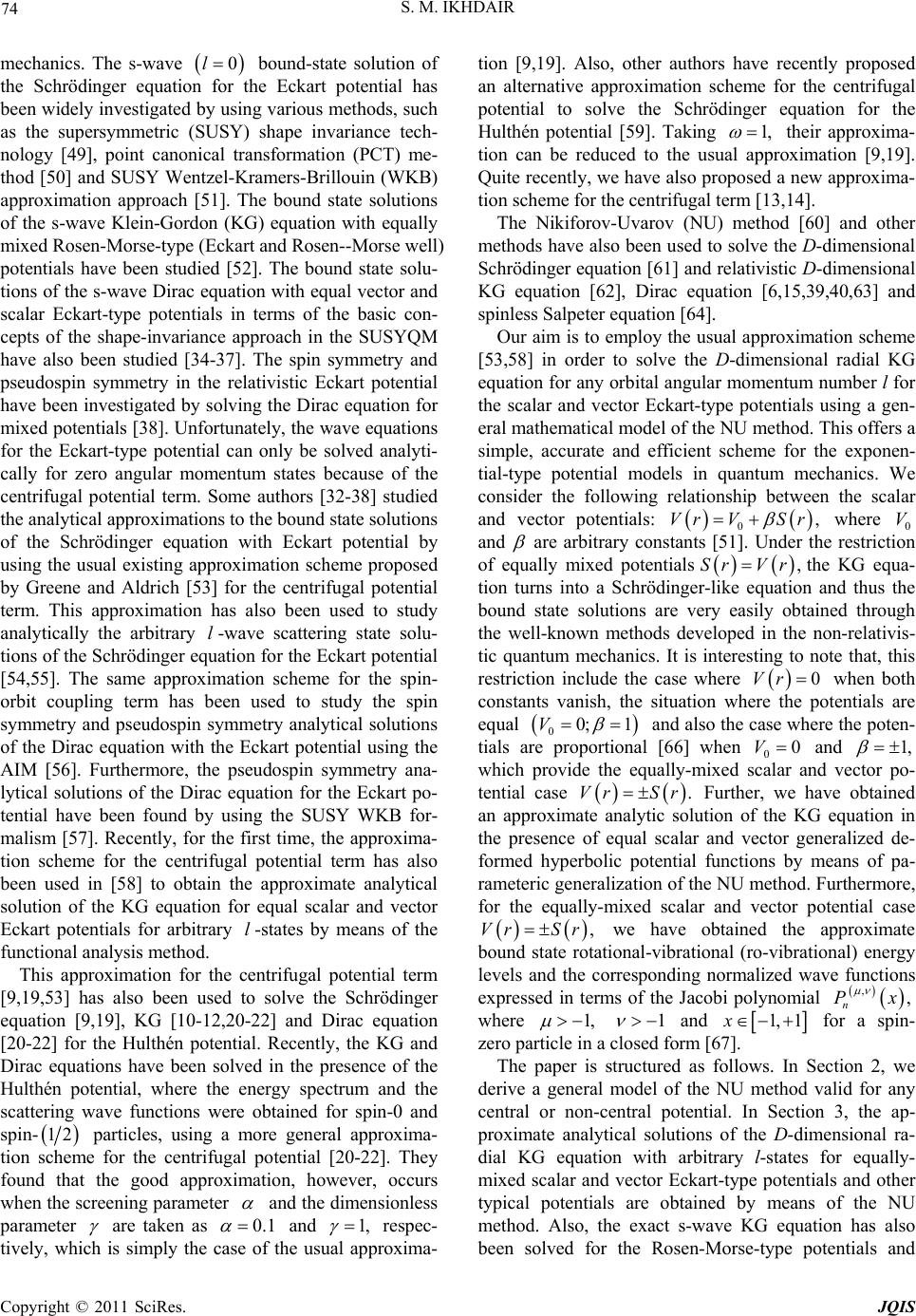 S. M. IKHDAIR 74 mechanics. The s-wave bound-state solution of the Schrödinger equation for the Eckart potential has been widely investigated by using various methods, such as the supersymmetric (SUSY) shape invariance tech- nology [49], point canonical transformation (PCT) me- thod [50] and SUSY Wentzel-Kramers-Brillouin (WKB) approximation approach [51]. The bound state solutions of the s-wave Klein-Gordon (KG) equation with equally mixed Rosen-Morse-type (Eckart and Rosen--Morse well) potentials have been studied [52]. The bound state solu- tions of the s-wave Dirac equation with equal vector and scalar Eckart-type potentials in terms of the basic con- cepts of the shape-invariance approach in the SUSYQM have also been studied [34-37]. The spin symmetry and pseudospin symmetry in the relativistic Eckart potential have been investigated by solving the Dirac equation for mixed potentials [38]. Unfortunately, the wave equations for the Eckart-type potential can only be solved analyti- cally for zero angular momentum states because of the centrifugal potential term. Some authors [32-38] studied the analytical approximations to the bound state solutions of the Schrödinger equation with Eckart potential by using the usual existing approximation scheme proposed by Greene and Aldrich [53] for the centrifugal potential term. This approximation has also been used to study analytically the arbitrary l-wave scattering state solu- tions of the Schrödinger equation for the Eckart potential [54,55]. The same approximation scheme for the spin- orbit coupling term has been used to study the spin symmetry and pseudospin symmetry analytical solutions of the Dirac equation with the Eckart potential using the AIM [56]. Furthermore, the pseudospin symmetry ana- lytical solutions of the Dirac equation for the Eckart po- tential have been found by using the SUSY WKB for- malism [57]. Recently, for the first time, the approxima- tion scheme for the centrifugal potential term has also been used in [58] to obtain the approximate analytical solution of the KG equation for equal scalar and vector Eckart potentials for arbitrary -states by means of the functional analysis method. 0l l This approximation for the centrifugal potential term [9,19,53] has also been used to solve the Schrödinger equation [9,19], KG [10-12,20-22] and Dirac equation [20-22] for the Hulthén potential. Recently, the KG and Dirac equations have been solved in the presence of the Hulthén potential, where the energy spectrum and the scattering wave functions were obtained for spin-0 and spin- 12 particles, using a more general approxima- tion scheme for the centrifugal potential [20-22]. They found that the good approximation, however, occurs when the screening parameter and the dimensionless parameter are taken as 0.1 and 1, respec- tively, which is simply the case of the usual approxima- tion [9,19]. Also, other authors have recently proposed an alternative approximation scheme for the centrifugal potential to solve the Schrödinger equation for the Hulthén potential [59]. Taking 1, their approxima- tion can be reduced to the usual approximation [9,19]. Quite recently, we have also proposed a new approxima- tion scheme for the centrifugal term [13,14]. The Nikiforov-Uvarov (NU) method [60] and other methods have also been used to solve the D-dimensional Schrödinger equation [61] and relativistic D-dimensional KG equation [62], Dirac equation [6,15,39,40,63] and spinless Salpeter equation [64]. Our aim is to employ the usual approximation scheme [53,58] in order to solve the D-dimensional radial KG equation for any orbital angular momentum number l for the scalar and vector Eckart-type potentials using a gen- eral mathematical model of the NU method. This offers a simple, accurate and efficient scheme for the exponen- tial-type potential models in quantum mechanics. We consider the following relationship between the scalar and vector potentials: 0 V ,VrSr where 0 and V are arbitrary constants [51]. Under the restriction of equally mixed potentials the KG equa- tion turns into a Schrödinger-like equation and thus the bound state solutions are very easily obtained through the well-known methods developed in the non-relativis- tic quantum mechanics. It is interesting to note that, this restriction include the case where when both constants vanish, the situation where the potentials are equal Sr V Vr ,r 0 00; 1V and also the case where the poten- tials are proportional [66] when 0 and 0V1, which provide the equally-mixed scalar and vector po- tential case .rVr Further, we have obtained an approximate analytic solution of the KG equation in the presence of equal scalar and vector generalized de- formed hyperbolic potential functions by means of pa- rameteric generalization of the NU method. Furthermore, for the equally-mixed scalar and vector potential case S ,Sr 1, Vr we have obtained the approximate bound state rotational-vibrational (ro-vibrational) energy levels and the corresponding normalized wave functions expressed in terms of the Jacobi polynomial n where , ,Px 1 and 1,x 1 for a spin- zero particle in a closed form [67]. The paper is structured as follows. In Section 2, we derive a general model of the NU method valid for any central or non-central potential. In Section 3, the ap- proximate analytical solutions of the D-dimensional ra- dial KG equation with arbitrary l-states for equally- mixed scalar and vector Eckart-type potentials and other typical potentials are obtained by means of the NU method. Also, the exact s-wave KG equation has also been solved for the Rosen-Morse-type potentials and Copyright © 2011 SciRes. JQIS 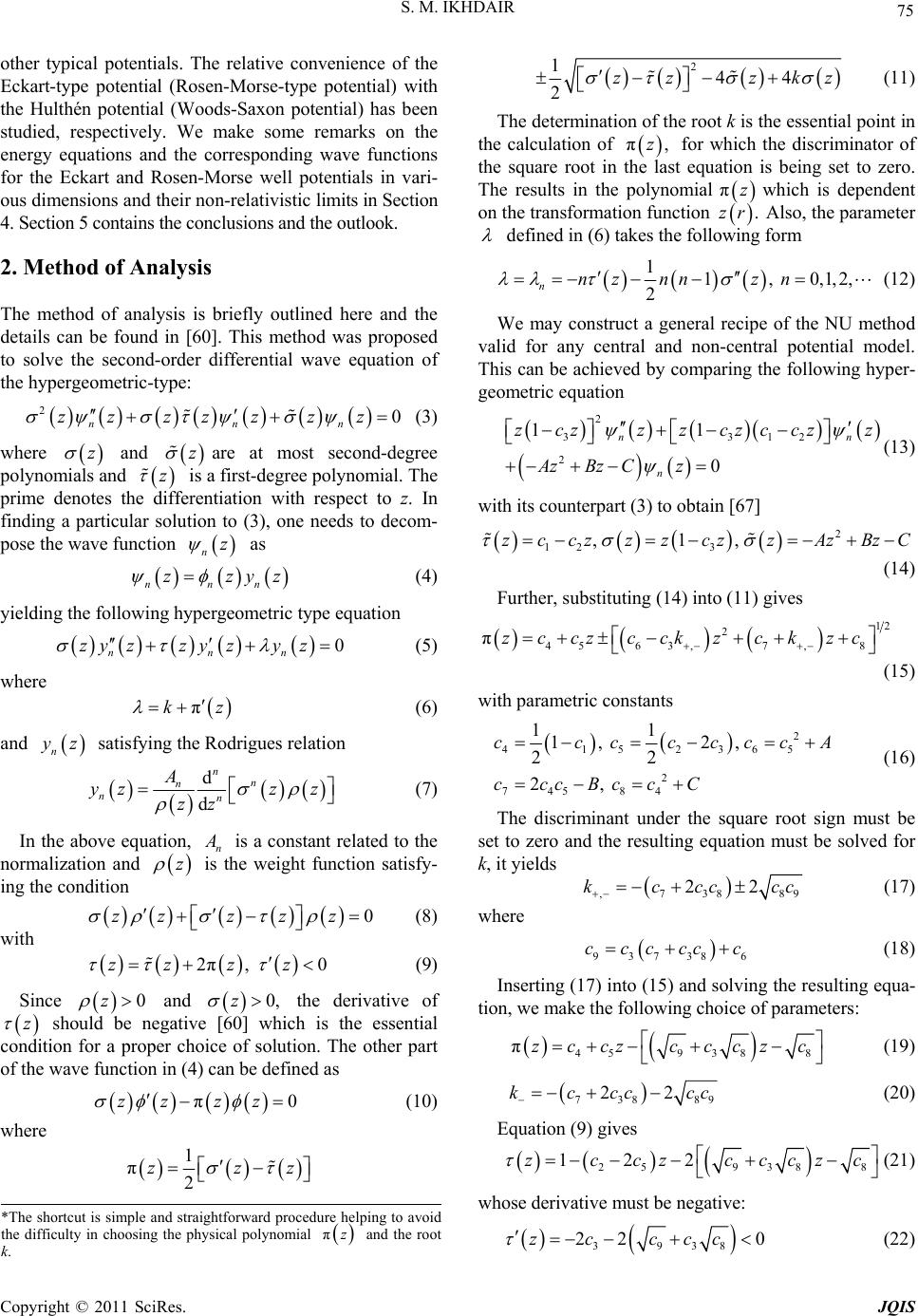 75 S. M. IKHDAIR other typical potentials. The relative convenience of the Eckart-type potential (Rosen-Morse-type potential) with the Hulthén potential (Woods-Saxon potential) has been studied, respectively. We make some remarks on the energy equations and the corresponding wave functions for the Eckart and Rosen-Morse well potentials in vari- ous dimensions and their non-relativistic limits in Section 4. Section 5 contains the conclusions and the outlook. 2. Method of Analysis The method of analysis is briefly outlined here and the details can be found in [60]. This method was proposed to solve the second-order differential wave equation of the hypergeometric-type: 20 nnn zz zzz zz z z (3) where and are at most second-degree polynomials and is a first-degree polynomial. The prime denotes the differentiation with respect to z. In finding a particular solution to (3), one needs to decom- pose the wave function as z z z n z nnn zzy (4) yielding the following hypergeometric type equation 0 nnn zy zzy zyz (5) where πk (6) and n z satisfying the Rodrigues relation d d n n n nn A yzz z zz (7) In the above equation, n is a constant related to the normalization and is the weight function satisfy- ing the condition z 0zzzz z (8) with 2π, 0zz zz (9) Since and the derivative of should be negative [60] which is the essential condition for a proper choice of solution. The other part of the wave function in (4) can be defined as 0z 0,z z π0zz zz (10) where 1 π2 zz 2 144 2zz zk z (11) The determination of the root k is the essential point in the calculation of π,z for which the discriminator of the square root in the last equation is being set to zero. The results in the polynomial which is dependent on the transformation function Also, the parameter πz .zr defined in (6) takes the following form 11, 0,1,2, 2 nnznnzn (12) We may construct a general recipe of the NU method valid for any central and non-central potential model. This can be achieved by comparing the following hyper- geometric equation 2 3312 2 11 0 nn n zczzzczcczz AzBz Cz (13) with its counterpart (3) to obtain [67] 2 12 3 ,1,zcczzz czzAzBzC (14) Further, substituting (14) into (11) gives 12 2 4563,7 ,8 πzcczcck zck zc (15) with parametric constants 2 4152365 2 745 84 11 1, 2, 22 2, ccccccc cccBccC A (16) The discriminant under the square root sign must be set to zero and the resulting equation must be solved for k, it yields ,7388 22kccccc 9 (17) where 93738 cccccc 6 (18) Inserting (17) into (15) and solving the resulting equa- tion, we make the following choice of parameters: 459388 πzcczcccz c (19) 7388 22kc cccc 9 (20) Equation (9) gives 25938 8 122zcczccczc (21) z whose derivative must be negative: *The shortcut is simple and straightforward procedure helping to avoid the difficulty in choosing the physical polynomial and the root k. πz 3938 22zc ccc 0 (22) Copyright © 2011 SciRes. JQIS 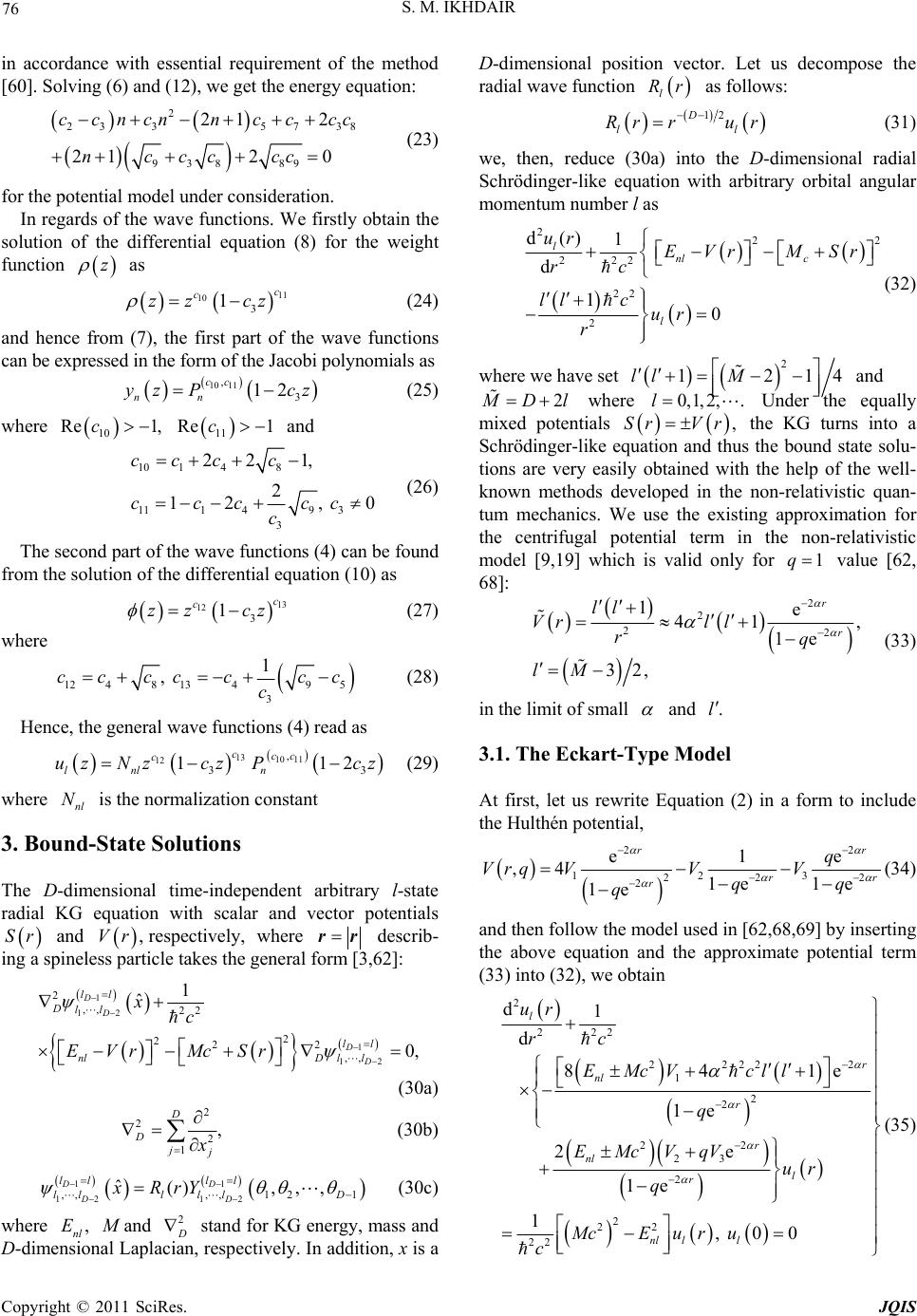 S. M. IKHDAIR 76 in accordance with essential requirement of the method [60]. Solving (6) and (12), we get the energy equation: 2 23357 3 93889 212 212 0 ccncnncccc nccc cc 8 (23) for the potential model under consideration. In regards of the wave functions. We firstly obtain the solution of the differential equation (8) for the weight function as z 11 10 3 1c c zz cz (24) and hence from (7), the first part of the wave functions can be expressed in the form of the Jacobi polynomials as 10 11 , 3 12 cc nn yz Pcz (25) where and 10 11 Re1, Re1cc 10 148 11149 3 3 22 1, 2 12, 0 ccc c ccc cc c (26) The second part of the wave functions (4) can be found from the solution of the differential equation (10) as 13 12 3 1c c zz cz (27) where 1248 13495 3 1 , cc ccccc c 2 (28) Hence, the general wave functions (4) read as 13 10 11 12 , 33 11 ccc c lnl n uz Nzcz Pcz (29) where is the normalization constant nl N 3. Bound-State Solutions The D-dimensional time-independent arbitrary l-state radial KG equation with scalar and vector potentials and respectively, where Sr ,Vr rr describ- ing a spineless particle takes the general form [3,62]: 1 12 1 12 2 ,, 22 2 222 ,, 1 ˆ 0, D D D D ll Dll ll nlD ll xc EVr McSr (30a) 2 2 2 1 , D D j (30b) 11 12 12 12 1 ,, ,, ˆ(), , , DD DD ll ll lD ll ll xRrY (30c) where M and , nl E2 stand for KG energy, mass and D-dimensional Laplacian, respectively. In addition, x is a D-dimensional position vector. Let us decompose the radial wave function l Rr as follows: 12D l r l Rr ur (31) we, then, reduce (30a) into the D-dimensional radial Schrödinger-like equation with arbitrary orbital angular momentum number l as 2 nl l ur 222 22 22 2 d() 1 d 10 l c ur EVr MSr rc ll c r (32) where we have set 2 1214M ll and 2 Dl where 0,1l,2,. Under the equally mixed potentials Sr ,Vr the KG turns into a Schrödinger-like equation and thus the bound state solu- tions are very easily obtained with the help of the well- known methods developed in the non-relativistic quan- tum mechanics. We use the existing approximation for the centrifugal potential term in the non-relativistic model [9,19] which is valid only for value [62, 68]: 1q 2 2 1 , 22 e 41 , 1e 32 r r ll Vrl l rq lM (33) in the limit of small and .l 3.1. The Eckart-Type Model At first, let us rewrite Equation (2) in a form to include the Hulthén potential, 22 12 r V3 22 2 2 e1e ,4 1e 1e 1e rr rr q Vrq VV qq q (34) and then follow the model used in [62,68,69] by inserting the above equation and the approximate potential term (33) into (32), we obtain 2 222 2222 2 2 2 22 23 2 22 d1 d 1e 1e 2e 1, 00 l r nl r r nl l l ur rc EM cll q EMqV ur Mcru c 1 2 22 84 1e r nl l cV cV q E u (35) Copyright © 2011 SciRes. JQIS 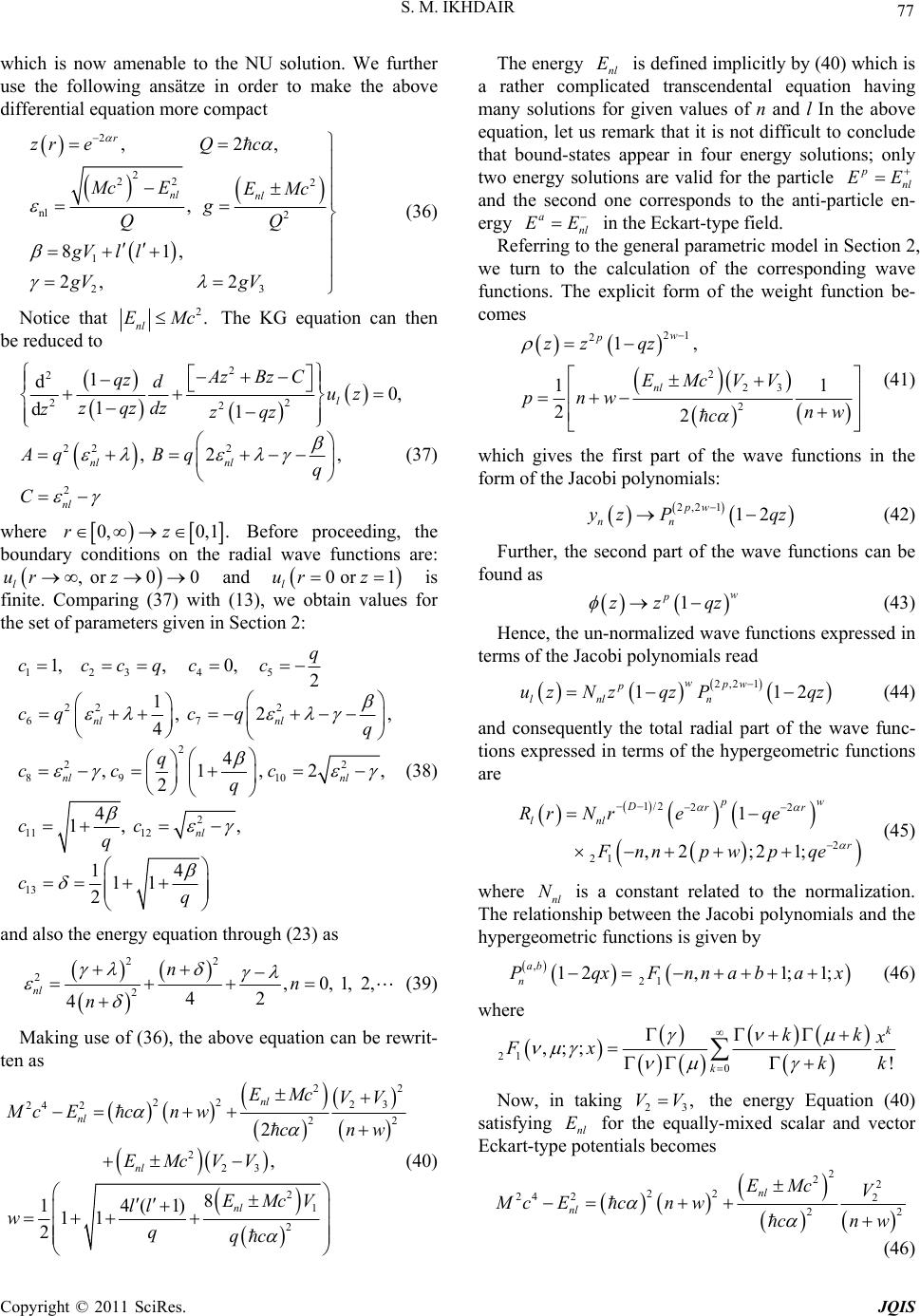 77 S. M. IKHDAIR which is now amenable to the NU solution. We further use the following ansätze in order to make the above differential equation more compact 2 2 22 2 nl 2 1 23 , 2, , 81, 2, 2 r nl nl zr eQc Mc EEMc g QQ gVl l gV gV (36) Notice that 2. nl EMc The KG equation can then be reduced to 2 2 22 2 22 2 2 1 d0, 1 d1 , 2, l nl nl nl AzBz C qz duz zqzdz zzqz Aq Bqq C (37) where 0,0,1 .rz , or 00z Before proceeding, the boundary conditions on the radial wave functions are: l and is finite. Comparing (37) with (13), we obtain values for the set of parameters given in Section 2: ur 0 or 1 l ur z 1234 5 22 2 67 2 2 89 10 2 11 12 13 1, , 0,2 1, 2, 4 4 ,1,2 2 4 1, , 14 11 2 nl nl nl nl nl q cccqcc cqc qq q cc c q cc q cq 2 , (38) and also the energy equation through (23) as 22 2 2,0, 1, 2, 42 4 nl nn n (39) Making use of (36), the above equation can be rewrit- ten as 22 22 23 24 2 22 2 23 2 1 2 2 , 8 14(1) 11 2 nl nl nl nl EMc VV McEcnw cnw EMcVV EMcV ll wqqc (40) The energy nl is defined implicitly by (40) which is a rather complicated transcendental equation having many solutions for given values of n and l In the above equation, let us remark that it is not difficult to conclude that bound-states appear in four energy solutions; only two energy solutions are valid for the particle E p nl EE and the second one corresponds to the anti-particle en- ergy a nl EE in the Eckart-type field. Referring to the general parametric model in Section 2, we turn to the calculation of the corresponding wave functions. The explicit form of the weight function be- comes 21 2 2 23 2 1, 11 22 w p nl zz qz EMcVV pnw nw c (41) which gives the first part of the wave functions in the form of the Jacobi polynomials: 2,21 12 pw nn yz Pqz 12 (42) Further, the second part of the wave functions can be found as 1w p zz qz (43) Hence, the un-normalized wave functions expressed in terms of the Jacobi polynomials read 2,2 1 1 wpw p lnl n uzNzqzPqz (44) and consequently the total radial part of the wave func- tions expressed in terms of the hypergeometric functions are 1/222 2 21 1 ,2;21; pw Drr lnl r Rr Nreqe Fnnpw pqe (45) where nl is a constant related to the normalization. The relationship between the Jacobi polynomials and the hypergeometric functions is given by N , 21 12,1; 1; ab n qxFnnabax (46) where 21 0 ,;; ! k k kk Fx kk Now, in taking 23 ,VV the energy Equation (40) satisfying nl for the equally-mixed scalar and vector Eckart-type potentials becomes E 2 22 22 24 22 22 nl nl EMcV McEcnw cnw (46) Copyright © 2011 SciRes. JQIS 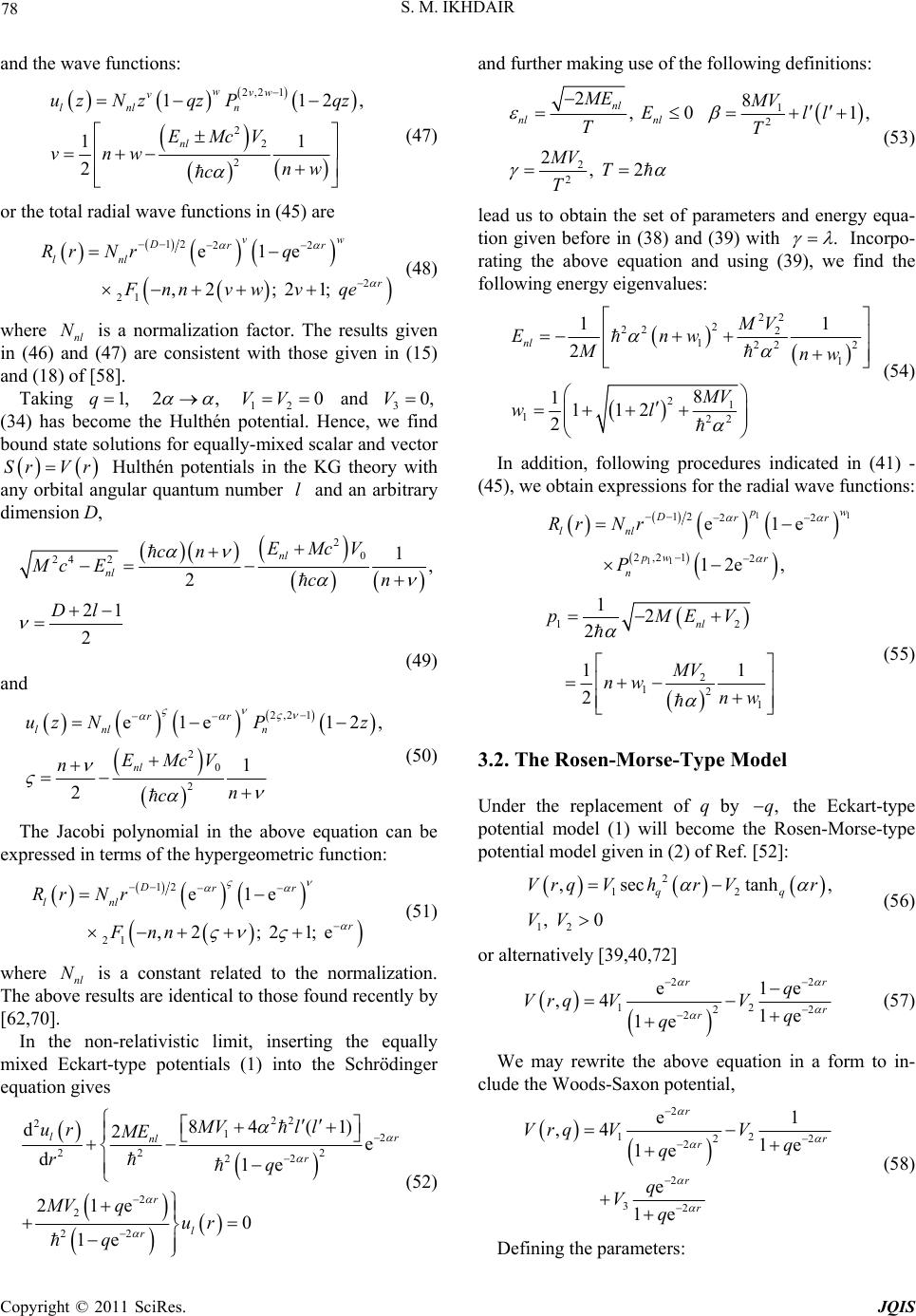 S. M. IKHDAIR 78 and the wave functions: 2,2 1 2 2 2 11 11 2 wvw v lnl n nl uzNzqz Pqz EMcV vnw nw c 2, (47) or the total radial wave functions in (45) are 12 22 2 21 e1e ,2;21; vw Drr lnl r Rr Nrq Fnnvw vqe (48) where nl is a normalization factor. The results given in (46) and (47) are consistent with those given in (15) and (18) of [58]. N Taking 1,q2, 12 and 3 0VV 0,V (34) has become the Hulthén potential. Hence, we find bound state solutions for equally-mixed scalar and vector Sr Vr Hulthén potentials in the KG theory with any orbital angular quantum number and an arbitrary dimension D, l 2 0 24 21, 2 21 2 nl nl EMcV cn Mc Ecn Dl (49) and 2,21 2 0 2 e1e 12 1 2 rr lnl n nl uz NPz EMcV n n c , (50) The Jacobi polynomial in the above equation can be expressed in terms of the hypergeometric function: 12 21 e1e ,2;21;e Drr lnl r Rr Nr Fnn (51) where nl is a constant related to the normalization. The above results are identical to those found recently by [62,70]. N In the non-relativistic limit, inserting the equally mixed Eckart-type potentials (1) into the Schrödinger equation gives 22 2 12 22 2 22 2 2 22 84(1) d2e d1e 21e 0 1e lr nl r r l r MVll ur ME rq MV qur q (52) and further making use of the following definitions: 1 2 2 2 28 , 0 1, 2, 2 nl nl nl ME MV El TT MV T T l (53) lead us to obtain the set of parameters and energy equa- tion given before in (38) and (39) with . Incorpo- rating the above equation and using (39), we find the following energy eigenvalues: 22 2 22 2 1222 1 21 122 11 2 8 1112 2 nl MV Enw Mnw MV wl (54) In addition, following procedures indicated in (41) - (45), we obtain expressions for the radial wave functions: 11 11 12 22 2,2 12 e1e 12e, w Drr lnl pw r n Rr Nr P 12 2 12 1 12 2 11 2 nl pMEV MV nw nw (55) 3.2. The Rosen-Morse-Type Model Under the replacement of q by the Eckart-type potential model (1) will become the Rosen-Morse-type potential model given in (2) of Ref. [52]: ,q 2 12 12 ,sec tanh , 0 qq VrqVhr Vr VV , (56) or alternatively [39,40,72] 22 12 2 2 e1 ,4 1e 1e rr r r q VrqVV q q2 e (57) We may rewrite the above equation in a form to in- clude the Woods-Saxon potential, 2 12 22 2 2 32 e1 ,4 1e 1e e 1e r r r r r VrqVV q q q Vq (58) Defining the parameters: Copyright © 2011 SciRes. JQIS  79 S. M. IKHDAIR 2 22 2 00 n0 2 1 2 3 , 08, 02, 02 nn Mc EEMc g QQ lgV lgV lgV (59) we can easily write the s-wave KG equation with Sr for the potential (58) as Vr 2 2 22 2 22 2 0 2 0 1 dd 0, 1d d1 , 2, n nnl n AzBz C qz uz zqzz zzqz Aq Bqq C (60) Following the steps of solution mentioned in the pre- vious subsection, we may obtain values for the parame- ters given in Section 2: 1234 5 22 2 607 0 2 2 80 9100 2 1112 0 13 1, , 0, 2 1, 2, 4 4 , 1, 2, 2 4 1, , 14 11 2 nn n n q cccqc c cqcq q q ccc q cc q cq 2 n (61) and the energy equation 22 2 02, 0, 1, 2, 42 4 n n n n (62) Inserting (59) in the above equation, we obtain energy equation satisfying 0, n E 222 0 22 23 24 2 02 2 023 2 01 2 2 , 8 111 2 n n n n EMc VV McEcn w cnw EMcVV EMcV w qc 2 (63) The corresponding un-normalized wave functions can be calculated as before. The explicit form of the weight function reads 21 2 2 023 2 1, 11 22 w p n zz qz EMcVV pnw nw c (64) which gives the Jacobi polynomials 2,21 12 pw nn yz Pqz 12 (65) as the first part of the wave function. The second part of the wave function can be found as 1w p zz qz (66) Hence, the un-normalized wave function reads 2,2 1 1 wpw p nnn uzNzqz Pqz (67) and thus the total radial part of the radial wave functions in (30) can be expressed in terms of the hypergeometric functions as 22 2 21 e1e ,2();21;e pw rr nn r Rr Nq Fnnpw pq (68) where is a normalization factor. n Taking 23 N VV in (63), we find the equation for the potential in (56) satisfying in the s-wave KG the- ory, 0n E 24 2 0 2 22 0 22 2 22 n n Mc E EMc V cnw cn w (69) and the wave functions take the form 1 22 2 211 1 ()e1 e ,2; 21; pw rr nn r ur Nq Fnnpw pqe (70a) 2 02 12 11 , 2 n EMcV pnw nw c (70b) where n is a normalization constant. After the fol- lowing mapping on the potential parameter: 11 VV in (56), the results in (69) and (70) become identical with (13) and (14) of [52]. N Also, taking 1,q 2, and 12 0VV 30 ,VV (58) turns to become the Woods-Saxon potential. Hence, we can find bound state solutions in the s-wave KG the- ory with equally-mixed scalar and vector Sr Vr for Woods-Saxon potentials as Copyright © 2011 SciRes. JQIS  S. M. IKHDAIR 80 2 0 24 20 022 2 , , 2 n n EMc V n McEcppn c (71) and wave functions: 22 2,1 e12 pp rr nn n ur NP e, e r (72) or alternatively, it can be expressed in terms of the hy- pergeometric function as 2 2122 e,2; 21; p r nn RrNF nnpp (73) where n is a constant related to the normalization. Under appropriate parameter replacements, we obtain the non-relativistic limit of the energy eigenvalues and ei- genfunctions of the above two equations are N 0 0 2 11 , 0, 22 n MV n E Mn n (74) and 3 212 2 0 32 e,2; 21; 21, 2 p rr nn urNF nnpp MV n pn c e, (75) respectively, which is simply the solution of the Schrödinger equation for the potential rVr The above results are identical to those found before in [8]. 2Sr Vr. 2 4. Discussions In this section, at first, we choose appropriate parameters in the Eckart-type potential model to construct the Eckart potential, Rosen-Morse well and their PT-symmetric versions, and then discuss their energy equations in the framework of KG theory with equally mixed potentials. 4.1. Eckart Potential Model Taking the potential (1) turns to the standard Eckart potential [41] 1,q 2 121 coscoth, ,0VrVechrVrV V (76) In natural units (), we can obtain the energy equation (46) for the Eckart potential in space spinless KG theory as 1c 3D 2 2 22 22 2 22 21 2 , () 8 1 1121 2 nl nl nl VEM ME nwnw EMV wwq l which is identical with those given in Equation (22) of [52] under the equally-mixed potential restriction given by .Sr Vr The unnormalized wave function corresponding to the energy levels is 12 22 2 21 e1e ,2; 21; e, vw Drr lnl r Rr Nr Fnn vw v (78) where is a normalization factor. nl 1) For s-wave case, the centrifugal term N 2 2123 40DlDlr and hence 2 22 2 2123 e10 rr DlDle too. Thus, the energy eigenvalues take the following simple form 2 2 220 22 2 01 22 1 01 12 , () 8 111 . 2 n n n VEM ME nwnw EMV w (79) 2) In the non-relativistic approximation of the KG en- ergy equation (potential energies small compared to 2 c and EMc Equation (32) reduces into the form [72] 2 22 22 2 d(1) 2d . l l nl l ur ll VrSru r Mrr EMcur (80) When ,Vr Sr the energy spectrum obtained from (80) reduces to those energy spectrum obtained from the solution of the Schrödinger equation for the sum potential 2r.rV In other words, the non- relativistic limit is the Schrödinger-like equation for the potential 2 2 12 22 2 1e e 82 1e 1e r r r r VV . This can be achieved by making the parameter re- placements 2 R EMM and , NR EM E so the non-relativistic limit of our results in (46) reduces to , (77) 22 2 22 22 2 2 2 1, 2 NR MV Enw Mnw (81) and the corresponding wave functions in (48) become Copyright © 2011 SciRes. JQIS 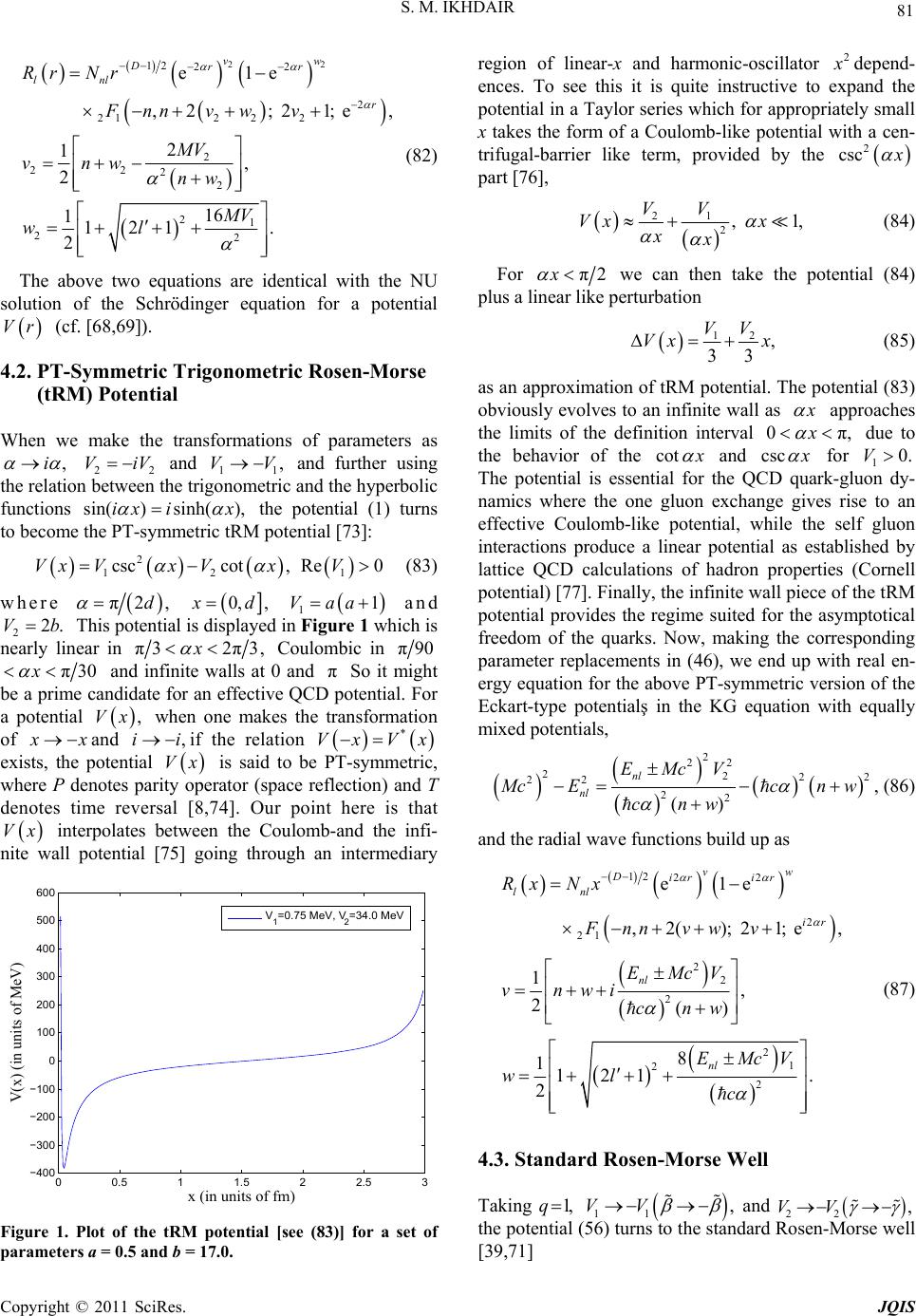 81 S. M. IKHDAIR 22 12 22 2 212 22 2 22 2 2 21 22 e1e ,2; 21; e, 2 1, 2 16 1121. 2 vw Drr lnl r Rr Nr Fnn vwv MV vnw nw MV wl (82) The above two equations are identical with the NU solution of the Schrödinger equation for a potential Vr (cf. [68,69]). 4.2. PT-Symmetric Trigonometric Rosen-Morse (tRM) Potential When we make the transformations of parameters as ,i 22 and 11 and further using the relation between the trigonometric and the hyperbolic functions ViV sin( )ix ,VV ), xsinh(i the potential (1) turns to become the PT-symmetric tRM potential [73]: 2 12 csccot, Re0VxVx VxV 1 (83) where π2,d 0, , d 11Vaa and 2 This potential is displayed in Figure 1 which is nearly linear in 2.Vb π32π3,x Coulombic in π90 πx30 and infinite walls at 0 and So it might be a prime candidate for an effective QCD potential. For a potential when one makes the transformation of π ,Vx x and if the relation ,ii * VxVx exists, the potential is said to be PT-symmetric, where P denotes parity operator (space reflection) and T denotes time reversal [8,74]. Our point here is that interpolates between the Coulomb-and the infi- nite wall potential [75] going through an intermediary Vx Vx 0 0.5 1 1.52 2.5 −400 −300 −200 −100 0 100 200 300 400 500 600 x (in units of fm) V 1 =0.75 MeV, V 2 =34.0 MeV Figure 1. Plot of the tRM potential [see (83)] for a set of parameters a = 0.5 and b = 17.0. region of linear-x and harmonic-oscillator 2 depend- ences. To see this it is quite instructive to expand the potential in a Taylor series which for appropriately small x takes the form of a Coulomb-like potential with a cen- trifugal-barrier like term, provided by the 2 ccs part [76], 21 2, 1, VV Vx x xx (84) For π2x we can then take the potential (84) plus a linear like perturbation 12 , 33 VV Vx x (85) as an approximation of tRM potential. The potential (83) obviously evolves to an infinite wall as approaches the limits of the definition interval 0π,x due to the behavior of the cot and csc for 1 The potential is essential for the QCD quark-gluon dy- namics where the one gluon exchange gives rise to an effective Coulomb-like potential, while the self gluon interactions produce a linear potential as established by lattice QCD calculations of hadron properties (Cornell potential) [77]. Finally, the infinite wall piece of the tRM potential provides the regime suited for the asymptotical freedom of the quarks. Now, making the corresponding parameter replacements in (46), we end up with real en- ergy equation for the above PT-symmetric version of the Eckart-type potentialş in the KG equation with equally mixed potentials, 0.V 2 22 2222 22 22, () nl nl EMcV McEcn w cnw (86) and the radial wave functions build up as 12 22 2 21 2 2 2 2 1 2 2 e1e ,2(); 21; e, 1, 2() 8 1121. 2 vw Dir ir lnl ir nl nl Rx Nx Fnnvw v EMcV vnwi cnw EMcV wl c (87) 4.3. Standard Rosen-Morse Well Taking 1,q 11 ,VV and 22 ,VV the potential (56) turns to the standard Rosen-Morse well [39,71] Copyright © 2011 SciRes. JQIS 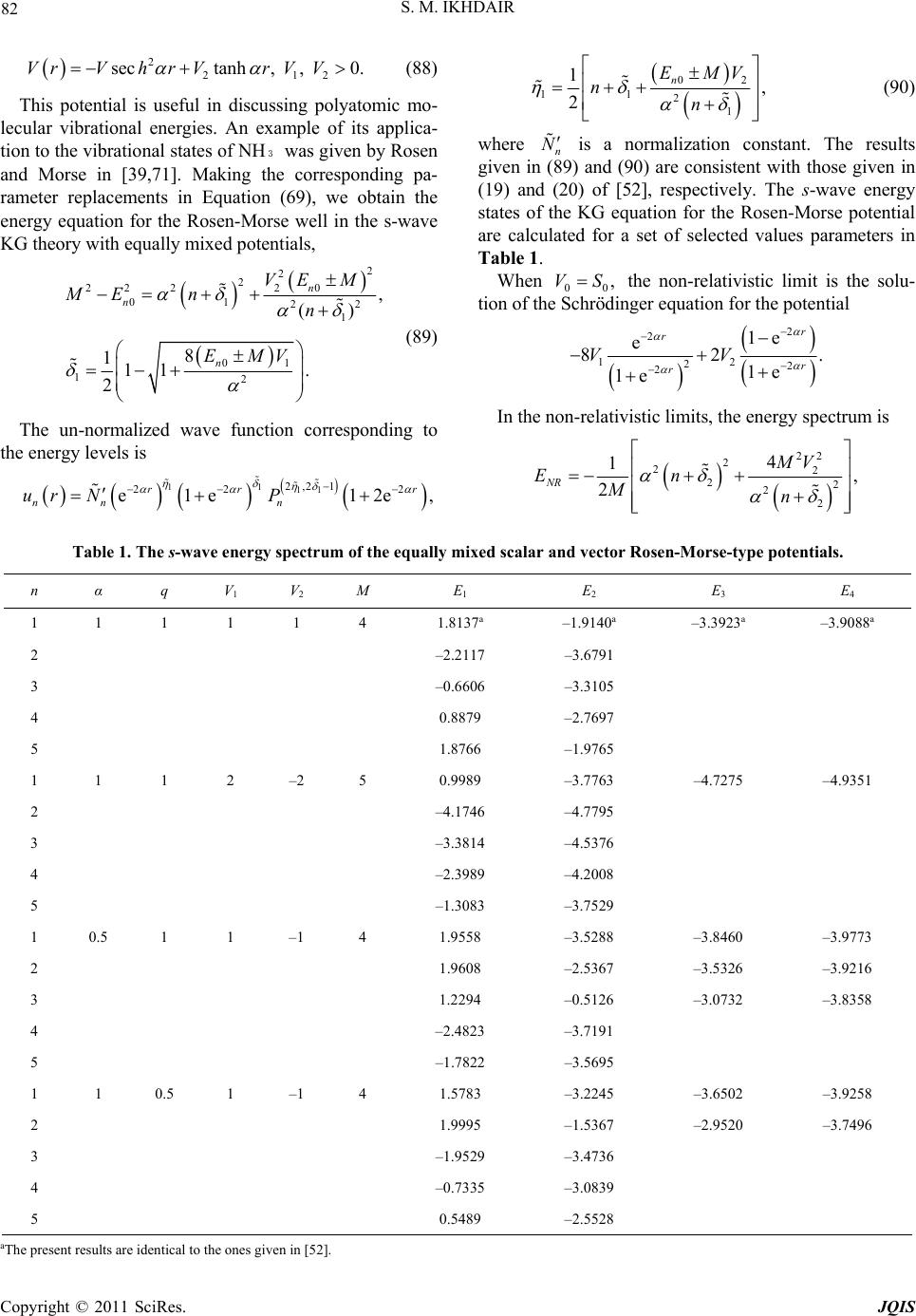 S. M. IKHDAIR Copyright © 2011 SciRes. JQIS 82 2 212 sectanh, , 0.VrVhr VrVV (88) 02 11 2 1 1, 2 n EMV n n (90) This potential is useful in discussing polyatomic mo- lecular vibrational energies. An example of its applica- tion to the vibrational states of NH₃ was given by Rosen and Morse in [39,71]. Making the corresponding pa- rameter replacements in Equation (69), we obtain the energy equation for the Rosen-Morse well in the s-wave KG theory with equally mixed potentials, where n N is a normalization constant. The results given in (89) and (90) are consistent with those given in (19) and (20) of [52], respectively. The s-wave energy states of the KG equation for the Rosen-Morse potential are calculated for a set of selected values parameters in Table 1. 2 2 220 22 2 01 22 1 01 12 , () 8 111 . 2 n n n VE M ME nn EMV (89) When 00 ,VS the non-relativistic limit is the solu- tion of the Schrödinger equation for the potential 2 2 12 22 2 1e e 82 1e 1e r r r r VV . In the non-relativistic limits, the energy spectrum is The un-normalized wave function corresponding to the energy levels is 22 2 22 22 2 2 4 1, 2 NR MV En Mn 11 11 2,2 1 22 2 e1e 12e rr nn n ur NP , r Table 1. The s-wave energy spectrum of the equally mixed scalar and vector Rosen-Morse-type potentials. n α q V1 V2 M E1 E2 E3 E4 1 1 1 1 1 4 1.8137a –1.9140a –3.3923a –3.9088a 2 –2.2117 –3.6791 3 –0.6606 –3.3105 4 0.8879 –2.7697 5 1.8766 –1.9765 1 1 1 2 –2 5 0.9989 –3.7763 –4.7275 –4.9351 2 –4.1746 –4.7795 3 –3.3814 –4.5376 4 –2.3989 –4.2008 5 –1.3083 –3.7529 1 0.5 1 1 –1 4 1.9558 –3.5288 –3.8460 –3.9773 2 1.9608 –2.5367 –3.5326 –3.9216 3 1.2294 –0.5126 –3.0732 –3.8358 4 –2.4823 –3.7191 5 –1.7822 –3.5695 1 1 0.5 1 –1 4 1.5783 –3.2245 –3.6502 –3.9258 2 1.9995 –1.5367 –2.9520 –3.7496 3 –1.9529 –3.4736 4 –0.7335 –3.0839 5 0.5489 –2.5528 aThe present results are identical to the ones given in [52]. 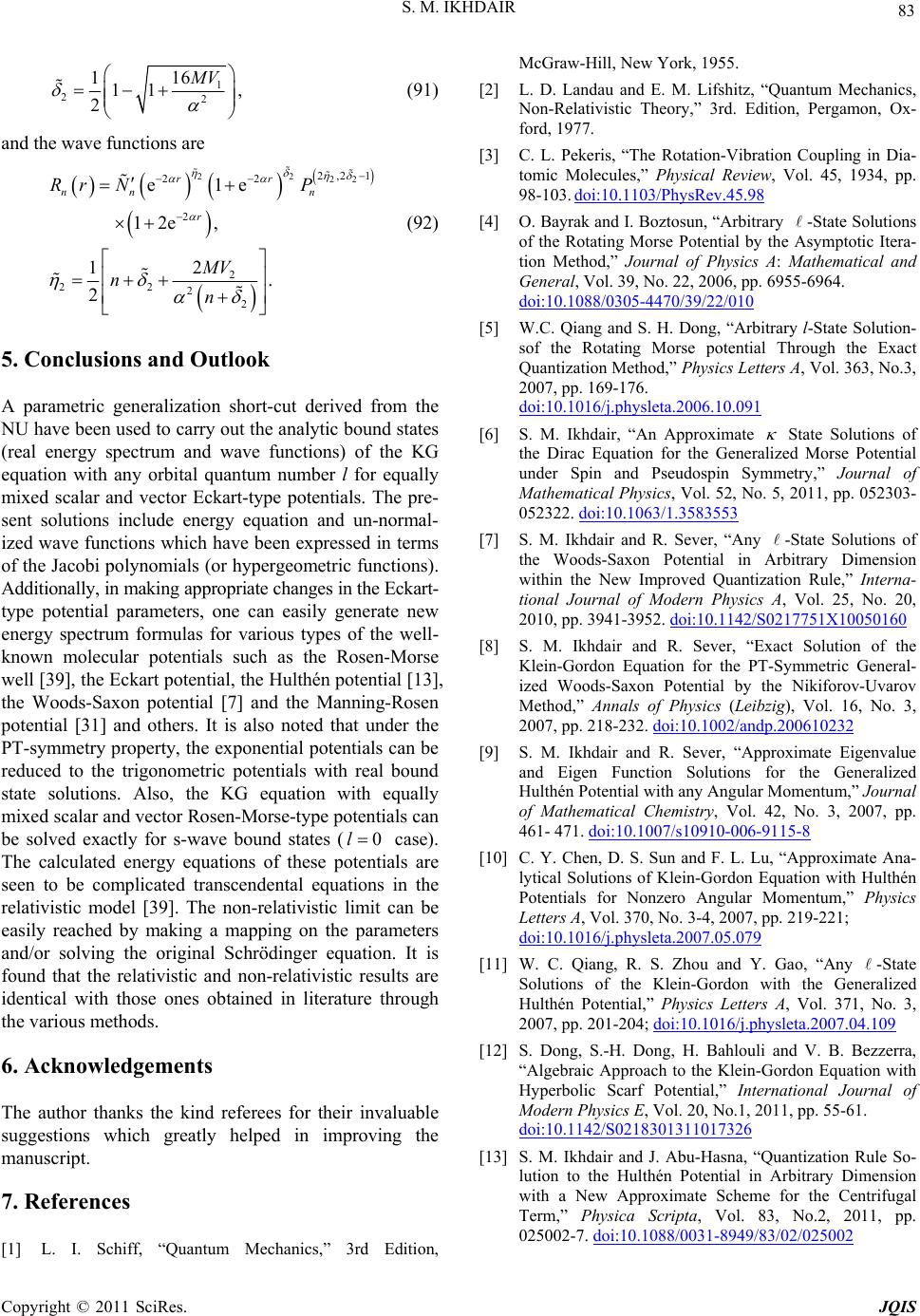 83 S. M. IKHDAIR 1 22 16 111 2 MV , (91) and the wave functions are 22 22 2,2 1 22 2 2 22 2 2 e1e 12e, 2 1. 2 rr nn n r Rr NP MV n n (92) 5. Conclusions and Outlook A parametric generalization short-cut derived from the NU have been used to carry out the analytic bound states (real energy spectrum and wave functions) of the KG equation with any orbital quantum number l for equally mixed scalar and vector Eckart-type potentials. The pre- sent solutions include energy equation and un-normal- ized wave functions which have been expressed in terms of the Jacobi polynomials (or hypergeometric functions). Additionally, in making appropriate changes in the Eckart- type potential parameters, one can easily generate new energy spectrum formulas for various types of the well- known molecular potentials such as the Rosen-Morse well [39], the Eckart potential, the Hulthén potential [13], the Woods-Saxon potential [7] and the Manning-Rosen potential [31] and others. It is also noted that under the PT-symmetry property, the exponential potentials can be reduced to the trigonometric potentials with real bound state solutions. Also, the KG equation with equally mixed scalar and vector Rosen-Morse-type potentials can be solved exactly for s-wave bound states ( case). The calculated energy equations of these potentials are seen to be complicated transcendental equations in the relativistic model [39]. The non-relativistic limit can be easily reached by making a mapping on the parameters and/or solving the original Schrödinger equation. It is found that the relativistic and non-relativistic results are identical with those ones obtained in literature through the various methods. 0l 6. Acknowledgements The author thanks the kind referees for their invaluable suggestions which greatly helped in improving the manuscript. 7. References [1] L. I. Schiff, “Quantum Mechanics,” 3rd Edition, McGraw-Hill, New York, 1955. [2] L. D. Landau and E. M. Lifshitz, “Quantum Mechanics, Non-Relativistic Theory,” 3rd. Edition, Pergamon, Ox- ford, 1977. [3] C. L. Pekeris, “The Rotation-Vibration Coupling in Dia- tomic Molecules,” Physical Review, Vol. 45, 1934, pp. 98-103. doi:10.1103/PhysRev.45.98 [4] O. Bayrak and I. Boztosun, “Arbitrary -State Solutions of the Rotating Morse Potential by the Asymptotic Itera- tion Method,” Journal of Physics A: Mathematical and General, Vol. 39, No. 22, 2006, pp. 6955-6964. doi:10.1088/0305-4470/39/22/010 [5] W.C. Qiang and S. H. Dong, “Arbitrary l-State Solution- sof the Rotating Morse potential Through the Exact Quantization Method,” Physics Letters A, Vol. 363, No.3, 2007, pp. 169-176. doi:10.1016/j.physleta.2006.10.091 [6] S. M. Ikhdair, “An Approximate State Solutions of the Dirac Equation for the Generalized Morse Potential under Spin and Pseudospin Symmetry,” Journal of Mathematical Physics, Vol. 52, No. 5, 2011, pp. 052303- 052322. doi:10.1063/1.3583553 [7] S. M. Ikhdair and R. Sever, “Any -State Solutions of the Woods-Saxon Potential in Arbitrary Dimension within the New Improved Quantization Rule,” Interna- tional Journal of Modern Physics A, Vol. 25, No. 20, 2010, pp. 3941-3952. doi:10.1142/S0217751X10050160 [8] S. M. Ikhdair and R. Sever, “Exact Solution of the Klein-Gordon Equation for the PT-Symmetric General- ized Woods-Saxon Potential by the Nikiforov-Uvarov Method,” Annals of Physics (Le ibz ig), Vol. 16, No. 3, 2007, pp. 218-232. doi:10.1002/andp.200610232 [9] S. M. Ikhdair and R. Sever, “Approximate Eigenvalue and Eigen Function Solutions for the Generalized Hulthén Potential with any Angular Momentum,” Journal of Mathematical Chemistry, Vol. 42, No. 3, 2007, pp. 461- 471. doi:10.1007/s10910-006-9115-8 [10] C. Y. Chen, D. S. Sun and F. L. Lu, “Approximate Ana- lytical Solutions of Klein-Gordon Equation with Hulthén Potentials for Nonzero Angular Momentum,” Physics Letters A, Vol. 370, No. 3-4, 2007, pp. 219-221; doi:10.1016/j.physleta.2007.05.079 [11] W. C. Qiang, R. S. Zhou and Y. Gao, “Any -State Solutions of the Klein-Gordon with the Generalized Hulthén Potential,” Physics Letters A, Vol. 371, No. 3, 2007, pp. 201-204; doi:10.1016/j.physleta.2007.04.109 [12] S. Dong, S.-H. Dong, H. Bahlouli and V. B. Bezzerra, “Algebraic Approach to the Klein-Gordon Equation with Hyperbolic Scarf Potential,” International Journal of Modern Physics E, Vol. 20, No.1, 2011, pp. 55-61. doi:10.1142/S0218301311017326 [13] S. M. Ikhdair and J. Abu-Hasna, “Quantization Rule So- lution to the Hulthén Potential in Arbitrary Dimension with a New Approximate Scheme for the Centrifugal Term,” Physica Scripta, Vol. 83, No.2, 2011, pp. 025002-7. doi:10.1088/0031-8949/83/02/025002 Copyright © 2011 SciRes. JQIS 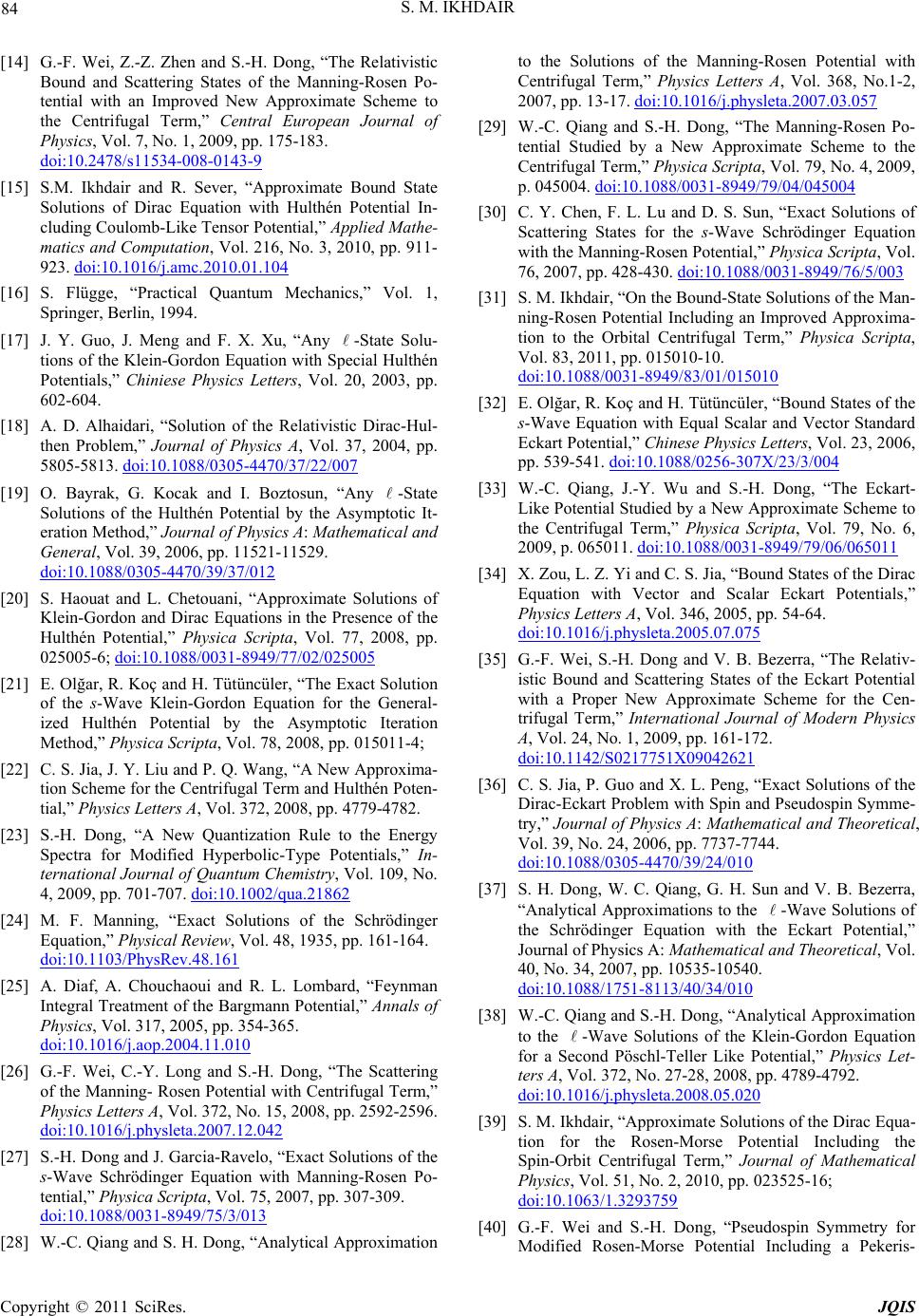 S. M. IKHDAIR 84 [14] G.-F. Wei, Z.-Z. Zhen and S.-H. Dong, “The Relativistic Bound and Scattering States of the Manning-Rosen Po- tential with an Improved New Approximate Scheme to the Centrifugal Term,” Central European Journal of Physics, Vol. 7, No. 1, 2009, pp. 175-183. doi:10.2478/s11534-008-0143-9 [15] S.M. Ikhdair and R. Sever, “Approximate Bound State Solutions of Dirac Equation with Hulthén Potential In- cluding Coulomb-Like Tensor Potential,” Applied Mathe- matics and Computation, Vol. 216, No. 3, 2010, pp. 911- 923. doi:10.1016/j.amc.2010.01.104 [16] S. Flügge, “Practical Quantum Mechanics,” Vol. 1, Springer, Berlin, 1994. [17] J. Y. Guo, J. Meng and F. X. Xu, “Any -State Solu- tions of the Klein-Gordon Equation with Special Hulthén Potentials,” Chiniese Physics Letters, Vol. 20, 2003, pp. 602-604. [18] A. D. Alhaidari, “Solution of the Relativistic Dirac-Hul- then Problem,” Journal of Physics A, Vol. 37, 2004, pp. 5805-5813. doi:10.1088/0305-4470/37/22/007 [19] O. Bayrak, G. Kocak and I. Boztosun, “Any -State Solutions of the Hulthén Potential by the Asymptotic It- eration Method,” Journal of Physics A: Mathematical and General, Vol. 39, 2006, pp. 11521-11529. doi:10.1088/0305-4470/39/37/012 [20] S. Haouat and L. Chetouani, “Approximate Solutions of Klein-Gordon and Dirac Equations in the Presence of the Hulthén Potential,” Physica Scripta, Vol. 77, 2008, pp. 025005-6; doi:10.1088/0031-8949/77/02/025005 [21] E. Olğar, R. Koç and H. Tütüncüler, “The Exact Solution of the s-Wave Klein-Gordon Equation for the General- ized Hulthén Potential by the Asymptotic Iteration Method,” Physica Scripta, Vol. 78, 2008, pp. 015011-4; [22] C. S. Jia, J. Y. Liu and P. Q. Wang, “A New Approxima- tion Scheme for the Centrifugal Term and Hulthén Poten- tial,” Physics Letters A, Vol. 372, 2008, pp. 4779-4782. [23] S.-H. Dong, “A New Quantization Rule to the Energy Spectra for Modified Hyperbolic-Type Potentials,” In- ternational Journal of Quantum Chemistry, Vol. 109, No. 4, 2009, pp. 701-707. doi:10.1002/qua.21862 [24] M. F. Manning, “Exact Solutions of the Schrödinger Equation,” Physical Review, Vol. 48, 1935, pp. 161-164. doi:10.1103/PhysRev.48.161 [25] A. Diaf, A. Chouchaoui and R. L. Lombard, “Feynman Integral Treatment of the Bargmann Potential,” Annals of Physics, Vol. 317, 2005, pp. 354-365. doi:10.1016/j.aop.2004.11.010 [26] G.-F. Wei, C.-Y. Long and S.-H. Dong, “The Scattering of the Manning- Rosen Potential with Centrifugal Term,” Physics Letters A, Vol. 372, No. 15, 2008, pp. 2592-2596. doi:10.1016/j.physleta.2007.12.042 [27] S.-H. Dong and J. Garcia-Ravelo, “Exact Solutions of the s-Wave Schrödinger Equation with Manning-Rosen Po- tential,” Physica Scripta, Vol. 75, 2007, pp. 307-309. doi:10.1088/0031-8949/75/3/013 [28] W.-C. Qiang and S. H. Dong, “Analytical Approximation to the Solutions of the Manning-Rosen Potential with Centrifugal Term,” Physics Letters A, Vol. 368, No.1-2, 2007, pp. 13-17. doi:10.1016/j.physleta.2007.03.057 [29] W.-C. Qiang and S.-H. Dong, “The Manning-Rosen Po- tential Studied by a New Approximate Scheme to the Centrifugal Term,” Physica Scripta, Vol. 79, No. 4, 2009, p. 045004. doi:10.1088/0031-8949/79/04/045004 [30] C. Y. Chen, F. L. Lu and D. S. Sun, “Exact Solutions of Scattering States for the s-Wave Schrödinger Equation with the Manning-Rosen Potential,” Physica Scripta, Vol. 76, 2007, pp. 428-430. doi:10.1088/0031-8949/76/5/003 [31] S. M. Ikhdair, “On the Bound-State Solutions of the Man- ning-Rosen Potential Including an Improved Approxima- tion to the Orbital Centrifugal Term,” Physica Scripta, Vol. 83, 2011, pp. 015010-10. doi:10.1088/0031-8949/83/01/015010 [32] E. Olğar, R. Koç and H. Tütüncüler, “Bound States of the s-Wave Equation with Equal Scalar and Vector Standard Eckart Potential,” Chinese Physics Letters, Vol. 23, 2006, pp. 539-541. doi:10.1088/0256-307X/23/3/004 [33] W.-C. Qiang, J.-Y. Wu and S.-H. Dong, “The Eckart- Like Potential Studied by a New Approximate Scheme to the Centrifugal Term,” Physica Scripta, Vol. 79, No. 6, 2009, p. 065011. doi:10.1088/0031-8949/79/06/065011 [34] X. Zou, L. Z. Yi and C. S. Jia, “Bound States of the Dirac Equation with Vector and Scalar Eckart Potentials,” Physics Letters A, Vol. 346, 2005, pp. 54-64. doi:10.1016/j.physleta.2005.07.075 [35] G.-F. Wei, S.-H. Dong and V. B. Bezerra, “The Relativ- istic Bound and Scattering States of the Eckart Potential with a Proper New Approximate Scheme for the Cen- trifugal Term,” International Journal of Modern Physics A, Vol. 24, No. 1, 2009, pp. 161-172. doi:10.1142/S0217751X09042621 [36] C. S. Jia, P. Guo and X. L. Peng, “Exact Solutions of the Dirac-Eckart Problem with Spin and Pseudospin Symme- try,” Journal of Physics A: Mathematical and Theoretical, Vol. 39, No. 24, 2006, pp. 7737-7744. doi:10.1088/0305-4470/39/24/010 [37] S. H. Dong, W. C. Qiang, G. H. Sun and V. B. Bezerra, “Analytical Approximations to the -Wave Solutions of the Schrödinger Equation with the Eckart Potential,” Journal of Physics A: Mathematical and Theoretical, Vol. 40, No. 34, 2007, pp. 10535-10540. doi:10.1088/1751-8113/40/34/010 [38] W.-C. Qiang and S.-H. Dong, “Analytical Approximation to the -Wave Solutions of the Klein-Gordon Equation for a Second Pöschl-Teller Like Potential,” Physics Let- ters A, Vol. 372, No. 27-28, 2008, pp. 4789-4792. doi:10.1016/j.physleta.2008.05.020 [39] S. M. Ikhdair, “Approximate Solutions of the Dirac Equa- tion for the Rosen-Morse Potential Including the Spin-Orbit Centrifugal Term,” Journal of Mathematical Physics, Vol. 51, No. 2, 2010, pp. 023525-16; doi:10.1063/1.3293759 [40] G.-F. Wei and S.-H. Dong, “Pseudospin Symmetry for Modified Rosen-Morse Potential Including a Pekeris- Copyright © 2011 SciRes. JQIS  85 S. M. IKHDAIR Type Approximation to the Pseudo-Centrifugal Term,” The European Physical Journal A, Vol. 46, No. 2, 2010, pp. 207-212. doi:10.1140/epja/i2010-11031-0 [41] C. Eckart, “The Penetration of a Potential Barrier by Electrons,” Physics Review, Vol. 35, No. 11, 1930, pp. 1303-1309. doi:10.1103/PhysRev.35.1303 [42] F. Cooper, A. Khare and U. Sukhatme, “Supersymmetry and Quantum Mechanics,” Physics Report, Vol. 251, No. 5-6, 1995, pp. 267-385. doi:10.1016/0370-1573(94)00080-M [43] J. J. Weiss, “Mechanism of Proton Transfer in Acid-Base Reactions,” Journal of Chemical Physics, Vol. 41, 1964, pp. 1120-1124. doi:10.1063/1.1726015 [44] A. Cimas, M. Aschi, C. Barrientos, V. M. Rayőn, J. A. Sordo and A. Largo, “Computational Study on the Kinet- ics of the Reaction of 4 Swith 2 CHF ,” Chemical Physics Letters , Vol. 374, No. 5-6, 2003, pp. 594-600. doi:10.1016/S0009-2614(03)00771-1 [45] C. S. Jia, X. L. Zeng and L. T. Sun, “PT Symmetry and Shape Invariance for a Potential Well with a Barrier,” Physics Letters A, Vol. 294, No. 3-4, 2002, pp. 185-189. doi:10.1016/S0375-9601(01)00840-4 [46] C. S. Jia, Y. Li, Y. Sun, J. Y. Liu and L. T. Sun, “Bound States of the Five Parametric Exponential-Type Potential Model,” Physics Letters A, Vol. 311, No. 2-3, 2003, pp. 115-125. doi:10.1016/S0375-9601(03)00502-4 [47] H. Eğrifes, D. Demirhan and F. Büyükkılıç, “Exact Solu- tions of the Schrödinger Equation for Two Deformed Hyperbolic Molecular Potentials,” Physica Scripta, Vol. 60, No.3, 1999, pp. 195-198. doi:10.1238/Physica.Regular.060a00195 [48] A. Arai, “Exactly Solvable Supersymmetric Quantum Mechanics,” Journal of Mathematical Analysis and Ap- plications, Vol. 158, No.1, 1991, pp. 63-79. doi:10.1016/0022-247X(91)90267-4 [49] R. Dutt, A. Khare and U. Sukhatme, “Supersymmetry, Shape Invariance, and Exactly Solvable Potentials,” American Journal of Physics, Vol. 56, No.2, 1988, pp. 163-168. doi:10.1119/1.15697 [50] R. De, R. Dutt and U. Sukhatme, “Mapping of Shape Invariant Potentials Under Point Canonical Transforma- tions,” Journal of Physics A: Mathematical and General, Vol. 25, No. 13, 1992, pp. L843-L850. doi:10.1088/0305-4470/25/13/013 [51] M. Hruska, W.Y. Keung and U. Sukhatme, “Accuracy of semi classical Methods for Shape-Invariant Potentials,” Physics Review A, Vol. 55, No. 5, 1997, pp. 3345-3350. doi:10.1103/PhysRevA.55.3345 [52] L.Z. Yi, Y.F. Diao, J.Y. Liu and C.S. Jia, “Bound States of the Klein-Gordon Equation with Vector and Scalar Rosen-Morse-Type Potentials,” Physics Letters A, Vol. 333, 2004, pp. 212-217. doi:10.1016/j.physleta.2004.10.054 [53] R.L. Greene and C. Aldrich, “Variational Wave Func- tions for a Screened Coulomb Potential,” Physics Review A, Vol. 14, 1976, pp. 2363-2366. doi:10.1103/PhysRevA.14.2363 [54] G. F. Wei, C. Y. Long, X. Y. Duan and S. H. Dong, “Ar- bitrary -Wave Scattering State Solutions of the Schrödinger Equation for the Eckart Potential,” Physica Scripta, Vol. 77, 2008, pp. 035001-5. doi:10.1088/0031-8949/77/03/035001 [55] C. Y. Chen, D. S. Sun and F.L. Lu, “Analytical Ap- proximations of Scattering States to the -Wave Solu- tions for the Schrödinger Equation with the Eckart Poten- tial,” Journal of Physics A: Mathematical and Theoretical, Vol. 41, No. 3, 2008, pp. 035302. doi:10.1088/1751-8113/41/3/035302 [56] A. Soylu, O. Bayrak and I. Boztosun, “ -State Solutions of the Dirac Equation for the Eckart Potential with Pseu- dospin- and Spin-Symmetry,” Journal of Physics A: Mathematical and Theoretical, Vol. 41, 2008, pp. 065308-8. doi:10.1088/1751-8113/41/6/065308 [57] L. H. Zhang, X. P. Li and C. S. Jia, “Analytical Ap- proximation to the Solution of the Dirac Equation with the Eckart Potential Including the Spin-Orbit Coupling Term,” Physics Letters A, Vol. 372, 2008, pp. 2201-2207. doi:10.1016/j.physleta.2007.11.022 [58] Y. Zhang, “Approximate Analytical Solutions of the Klein-Gordon Equation with scalar and Vector Eckart Potentials,” Physica Scripta, Vol. 78, 2008, pp. 015006-4. doi:10.1088/0031-8949/78/01/015006 [59] C. S. Jia, J. Y. Liu and P. Q. Wang, “A New Approxima- tion Scheme for the Centrifugal Term and the Hulthén Potential,” Physics Letters A, Vol. 372, No. 27-28, 2008, pp. 4779-4782. doi:10.1016/j.physleta.2008.05.030 [60] A. F. Nikiforov and V. B. Uvarov, “Special Functions of Mathematical Physics,” Birkhauser, Bassel, 1988. [61] S. M. Ikhdair and R. Sever, “Exact Quantization Rule to the Kratzer-Type Potentials: An Application to the Dia- tomic Molecules,” Journal of Mathematical Chemistry, Vol. 45, No. 4, 2009, pp. 1137-1152. doi:10.1007/s10910-008-9438-8 [62] S. M. Ikhdair and R. Sever, “Solutions of the Spatially- Dependent Mass Dirac Equation with the Spin and Pseu- dospin Symmetry for the Coulomb-Like Potential,” Ap- plied Mathematics and Computation, Vol. 216, No. 2, 2010, pp. 545-555. doi:10.1016/j.amc.2010.01.072 [63] S. M. Ikhdair, C. Berkdemir and R. Sever, “Spin and Pseudospin Symmetry Along With Orbital Dependency of the Dirac- Hulthén Problem,” Applied Mathematics and Computation, Vol. 217, No. 22, 2011, pp. 9019-9032. doi:10.1016/j.amc.2011.03.109 [64] S. M. Ikhdair and R. Sever, “Bound-States of a Semi- Relativistic Equation for the PT-Symmetric Generalized Potential by the Nikiforov-Uvarov Method,” International Journal of Modern Physics E, Vol. 17, No. 6, 2008, pp. 1107-1123. doi:10.1142/S0218301308010337 [65] A. de Souza Dutra and G. Chen, “On Some Classes of Exactly-Solvable Klein-Gordon Equations,” Physics Let- ters A, Vol. 349, 2006, pp. 297-301. doi:10.1016/j.physleta.2005.09.056 Copyright © 2011 SciRes. JQIS  S. M. IKHDAIR Copyright © 2011 SciRes. JQIS 86 [66] G. Chen, “Solutions of the Klein-Gordon for Exponential Scalar and Vector Potentials,” Physics Letters A, Vol. 339, 2005, pp. 300-303. doi:10.1016/j.physleta.2005.03.040 [67] S. M. Ikhdair, “Rotation and Vibration of Diatomic Molecule in the Spatially-Dependent Mass Schrodinger Equation with Generalized q-Deformed Morse Potential,” Chemical Physics, Vol. 361, No. 1-2, 2009, pp. 9-17. doi:10.1016/j.chemphys.2009.04.023 [68] N. Saad, “The Klein-Gordon Equation with a Generalized Hulthén Potential in D-Dimensions,” Physica Scripta, Vol. 76, 2007, pp. 623-627. doi:10.1088/0031-8949/76/6/005 [69] W. C. Qiang, R. S. Zhou and Y. Gao, “Any -State Solutions of the Klein-Gordon Equation with the Gener- alized Hulthén Potential,” Physics Letters A, Vol. 371, No. 3, 2007, pp. 201-204. doi:10.1016/j.physleta.2007.04.109 [70] S. M. Ikhdair and R. Sever, “Any -State Improved Quasi-Exact Analytical Solutions of the Spatially De- pendent Mass Klein-Gordon Equation for the Scalar and Vector Hulthén Potentials,” Physica Scripta, Vol. 79, No. 3, 2009, pp. 035002-12. doi:10.1088/0031-8949/79/03/035002 [71] N. Rosen and P. M. Morse, “On the Vibrations of Polya- tomic Molecules,” Physics Review, Vol. 42, No. 2, 1932, pp. 210-217. doi:10.1103/PhysRev.42.210 [72] A. S. de Castro, “Klein-Gordon Particles in Mixed Vec- tor-Scalar Inversely Linear Potentials,” Physics Letters A, Vol. 338, 2005, p. 81. doi:10.1016/j.physleta.2005.02.027 [73] F. Cooper, A. Khare and U. P. Sukhatme, “Supersym- metry in Quantum Mechanics,” World Scientific, Singa- pore, 2001. [74] C. M. Bender and S. Boettcher, “Real Spectra in Non- Hermitian Hamiltonians Having PT Symmetry,” Physical Review Letters, Vol. 80, No. 24, 1998, pp. 5243-5246. doi:10.1103/PhysRevLett.80.5243 [75] C. B. C. Jasso, “Baryon Spectra in a Quark-Diquark Model with the Trigonometric Rosen- Morse Potential,” MS Thesis (in Spanish), Institute of Physics, Autonomous University of San Luis Potosi, México, 2005. [76] M. R. Spiegel, “Mathematical Handbook of Formulas and Tables,” McGraw-Hill Publishing Company, New York, 1968. [77] E. Eichten, K. Gottfried, T. Kinoshita, K.D. Lane and T.M. Yan, “Charmonium: Comparison with Experiment,” Physical Review D, Vol. 21, No. 1, 1980, pp. 203-233. doi:10.1103/PhysRevD.21.203
|